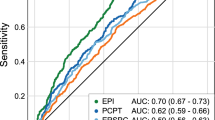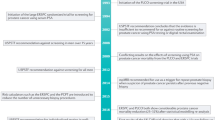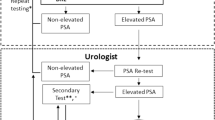Abstract
The purpose of this study was to determine if early PSA velocity (EPSAV), drawn from PSA values within normal ranges, predicts the later occurrence of abnormally high PSA values or positive prostate biopsy early enough to be clinically beneficial.
Early PSAV (ng/ml/y) calculated from two normal PSA readings was tested to predict later PSA exceeding 4 ng/ml (1551 evaluable patients) or 10 ng/ml (1905 evaluable patients) and positive prostate biopsy. The time from EPSAV to develop abnormal PSA was recorded.
A post-EPSAV PSA>4 ng/ml was reached by 367 patients and >10 by 293. EPSAV was significantly different (P<0.001) between patients whose PSA did or did not reach the PSA cut-off point and also significantly predicted a positive biopsy result (P<0.001). EPSAV predicted abnormal PSA more than 1 y in advance in 68 and 52% of the PSA 4 and 10 ng/ml cut-off point groups, respectively.
Early PSAV from normal PSA readings may allow early detection of men at risk for prostate cancer. This may help identify men for earlier prostate biopsy or for less frequent PSA monitoring.
This is a preview of subscription content, access via your institution
Access options
Subscribe to this journal
Receive 4 print issues and online access
$259.00 per year
only $64.75 per issue
Buy this article
- Purchase on Springer Link
- Instant access to full article PDF
Prices may be subject to local taxes which are calculated during checkout



Similar content being viewed by others
References
Polascik TJ, Oesterling JE, Partin AW . Prostate specific antigen: a decade of discovery—what we have learned and where we are going. J Urol 1999; 162: 293–306.
Catalona WJ, Richie JP, Ahmann FR, et al. Comparison of digital rectal examination and serum prostate specific antigen in the early detection of prostate cancer: results of a multicenter clinical trial of 6630 men. J Urol 1994; 151: 1283–1290.
Gann PH, Hennekens CH, Stampfer MJ . A prospective evaluation of plasma prostate-specific antigen for detection of prostate cancer. JAMA 1995; 273: 289.
Smith DS, Catalona WJ, Herschman JD . Longitudinal screening for prostate cancer with prostate-specific antigen. JAMA 1996; 276: 1309.
Carter HB, Pearson JD, Metter JE, et al. Longitudinal evaluation of prostate-specific antigen levels in men with and without prostate diseases. JAMA 1992; 267: 2215.
Smith DS, Catalona WJ . Rate of change of serum prostate specific antigen levels as a method for prostate cancer detection. J Urol 1994; 152: 1163–1167.
Carter HB, Pearson JD . Prostate-specific antigen velocity and repeated measures of prostate-specific antigen. Urol Clin N Am 1997; 24: 333–338.
Carter HB, Pearson JD, Waclawiw Z, et al. Prostate-specific antigen variability in men without prostate cancer: effect of sampling interval on prostate-specific antigen velocity. Urology 1995; 45: 591–596.
Lujan M, Paez A, Sanchez E, et al. Prostate specific antigen variation in patients without clinically evident prostate cancer. J Urol 1999; 162: 1311–1313.
Carter HB, Epstein JI, Chan DW, et al. Recommended PSA testing intervals for the detection of curable prostate cancer. JAMA 1997; 277: 1456.
Riffenburgh RH Statistics in Medicine Academic Press: San Diego, CA,. 1999
Choo R, deBoer G, Klotz L, et al. PSA doubling time of prostate carcinoma managed with watchful observation alone. Int J Radiat Oncol Biol Phys 2001; 50: 615–620.
Catalona WJ, Smith DS, Ornstein DK . Prostate cancer detection in men with serum PSA concentrations of 2.6 to 4.0 ng/ml and benign prostate examination. Enhancement of specificity with free-PSA measurements. JAMA 1997; 277: 1452–1455.
Djavan B, Zlotta A, Kratzik C, et al. PSA, PSA density, PSA density of transition zone, free/total PSA ratio, and PSA velocity for early detection of prostate cancer in men with serum PSA 2.5 to 4.0 ng/ml. Urology 1999; 54: 517–522.
Catalona WJ, Ramos CG, Carvalhal GF . Contemporary results of anatomical radical prostatectomy. CA Cancer J Clin 1999; 49: 282–296.
Author information
Authors and Affiliations
Corresponding author
Additional information
The opinions and assertions contained herein are the views of the authors and are not to be construed as reflecting the views of the US Navy or Department of Defense.
Appendix
Appendix
We wish to show the relationship between early PSA velocity (EPSAV) and PSA Doubling Time (DblT). Let us take the equation of a straight line as y=a+bx, where x is a position on the horizontal axis representing years, and y is a position on the vertical axis representing PSA values read at the respective x times. Let the first two PSA readings and their respective times be the (x, y) points (t1, p1) and (t2, p2). The slope of the line, b, is EPSAV=(p2−p1)/(t2−t1). Let us denote EPSAV as e to prevent ponderous formulae. Substituting the first point and e leads to the equation for the line through the two points, y=(p1−et1)+ex. We can denote the point at which PSA doubling occurs, that is, where y becomes 2p1, as (t3, 2p1). Substituting this point in the equation and solving for t3 yields t3=p1/e+t1. The time for PSA to double is t3−t1, so that DblT=p1/e, the initial PSA reading times the reciprocal of EPSAV.
Rights and permissions
About this article
Cite this article
Riffenburgh, R., Amling, C. Use of early PSA velocity to predict eventual abnormal PSA values in men at risk for prostate cancer. Prostate Cancer Prostatic Dis 6, 39–44 (2003). https://doi.org/10.1038/sj.pcan.4500614
Received:
Revised:
Accepted:
Published:
Issue Date:
DOI: https://doi.org/10.1038/sj.pcan.4500614
Keywords
This article is cited by
-
Are extended biopsies really necessary to improve prostate cancer detection?
Prostate Cancer and Prostatic Diseases (2003)



